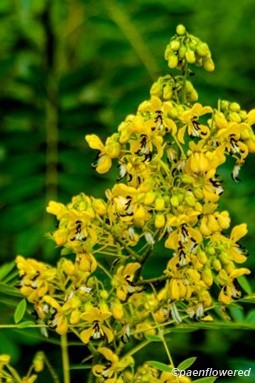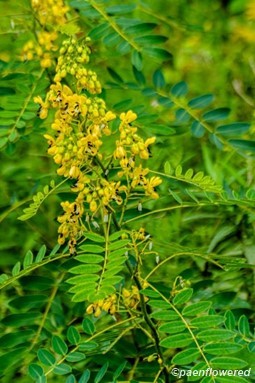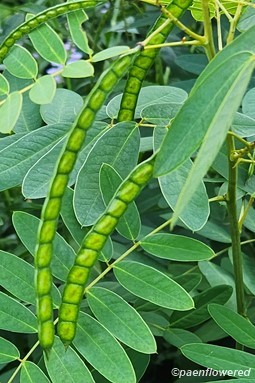Senna hebecarpa
Senna hebecarpa wild senna
This native member of the pea family has unusual and attractive flowers. It is a branched perennial plant with 6-8 inch long compound leaves. Each leaf has 5 to 10 pairs of oval leaflets. The leafstalk has a club-shaped gland at the base. The secretions from this gland secrete nectar that attracts ants and ladybugs. These insects may help protect the plant from other insects that might feed on the leaves. The large clusters of loosely constructed yellow or orange flowers arise from the leaf axils. The ten stamens of the individual flowers are unequal in length and the anthers are dark brown. Each scentless flower is about ¾ inch long and is not typically pea-like. There are five petals, slightly unequal. The petals have a tendency to turn white with age.
Bumblebees are the primary pollinators, though only for pollen because the flower produces no nectar. The plant grows 3-6 feet high and is found along roadsides, in thickets, and in disturbed areas throughout eastern United States. It blooms in July and August. After the initial blooms it is common to find blossoms at the top of the plant and the long seedpods hanging lower on the plant. These pods are flat, narrow and curved and very hairy. Each pod is divided into square segments. The plant may form colonies through the growth of its rhizome. Animals avoid eating the plant because it irritates the stomach.
Habitat & Range
Occasional on stream banks, sandy shores, moist old fields or wetland edges.
Present throughout, except in the northmost counties.
| EMP: | FAC |
|---|---|
| NCNE: | FACW |
Phenology
Flowers early July through August.
Plant Codes
S-rank: No rank
G-rank: G5 (Secure)







Comments
Have you spotted this plant in your area? We'd love to hear about your experience! Share your comments or questions about the plant below. Comments are moderated before posting.